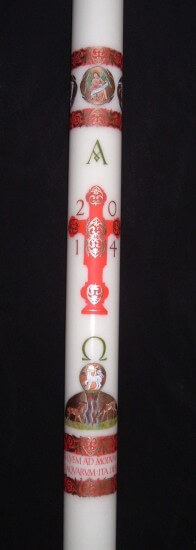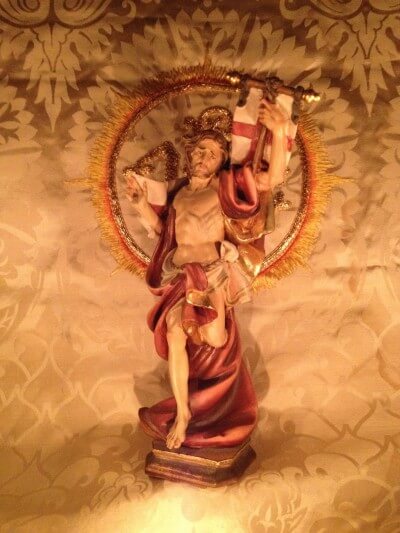(Janet McTeer as Jacquetta in The White Queen)
If you have been watching Philippa Gregory’s THE WHITE QUEEN on Starz no doubt you are captivated by Janet McTeer’s performance as Jacquetta Woodville, Elizabeth Woodville’s mother. Since the series starts when Elizabeth meets and marries the Queen, the audience is only privy to Jacquetta’s story through dialogue and her interaction with other characters. Jacquetta’s story, however, is interesting in its own right. Elizabeth Woodville would never have thought she could aim so high as to marry the King of England if she hadn’t had the example of her parents’ marriage before her. If a mere knight could marry the widow of a royal duke, brother and uncle of a king, then nothing was out of the realm of possibility. Jacquetta managed not only marry for love which was almost unheard of in the 15th century, but she also managed to thrive and survive not only under the Lancastrians but under the Yorks as well. If that weren’t impressive enough, she also managed to beat a charge of witchcraft.
Jacquetta was born sometime in 1416; the exact date is unknown, probably at the family chateau in France. She was the second child of a noble family. Her father Peter was the Count of Saint-Pol, Conversano and Brienne. He eventually inherited the title of Count of Luxembourg after the death of his great aunt. Her mother Margaret de Baux was descended from Simon de Montfort and Eleanor of England. Although her family wasn’t royalty per se, Jacquetta was a distant relation of Sigismund, the Holy Roman Emperor, and King of Bohemia and Hungary. She could also claim that she was descended from the water goddess Melusina who married Siegfried, the first Count of Luxembourg. Their marriage lasted until he saw her in her true guise, half-woman, half-fish, in the bathtub. He was understandably a little freaked out. Melusina and her bath sank through the rock of the castle and disappeared.
The world she was born into was a world at war. England and France had been fighting over the French throne since 1337. England claimed the throne through Edward II’s wife Isabella who was the daughter of Philip IV of France. Since France operated under Salic law, which meant women couldn’t inherit the throne, the crown had gone to distant branch of the family, the House of Valois. By the time Jacquetta was born the year after the English victory at Agincourt; the war had gone on for almost 80 years, decimating both France and England.
Her family was vassals of the Duke of Burgundy who sided with the English against their traditional enemy France. Jacquetta’s Uncle Louis served as John, Duke of Bedford’s chancellor for 10 years and was named executor of his will. Her other uncle, Jean of Luxembourg, was Joan of Arc’s jailor after one of his vassals captured her at the siege of Compiegne and brought her to Beaurevoir, the family chateau. Jean held her for 4 months while his wife, step-daughter and great-aunt pleaded with him not to turn Joan over to the English. However after his great-aunts death in 1430, Jean accepted 100,000 livres from the English to hand her over.
Jacquetta’s education was typical for young woman of her class. She was probably taught to read, but not to write. Rich people had scribes for that kind of thing. Nowadays we call them personal assistants. She was probably sent away as a young girl to live with noble relations, serving as a maid in waiting. She would have learned the skills necessary to be a lady of the manor, embroidery, music, dancing, how to manage servants and the household. She would need all those skills in her new life as the wife of John, Duke of Bedford. His wife, Anne of Burgundy, had died in November of 1432. It was a dynastic marriage, cementing the alliance between England and Burgundy. Five months after his wife’s death, 17 year old Jacquetta married the 42 year old Duke in a service performed by her uncle Louis. Apparently the Duke of Bedford fell hard for Jacquetta’s beauty and youth. However, the marriage came at a price. The Duke of Burgundy was furious; he considered the marriage an insult to his sister’s memory. The Duke of Bedford’s marriage brought neither territory nor a dowry. The alliance between Burgundy and England was hanging by a thread. Burgundy would soon ditch England and throw in his lot with the French.
Jacquetta was now the first Lady in France and the 2nd Lady in England behind Catherine of Valois, the Queen Mother. That must have been a huge responsibility for a 17 year old, but Jacquetta rose to the challenge. The marriage seems to have been happy although they never had children. Her husband not only had a huge library but also an alchemy laboratory, what more could a girl ask for? The couple spent a year in England after their wedding. The Duke of Bedford was at a crossroads. After devoting much of his life to overseeing English territories in France, he longed to retire but the situation in France was too dicey. Things weren’t much better in England. There was a power struggle going on in England between Humphrey, Duke of Gloucester, the uncle of Henry VI and Edmund Beaufort, Duke of Somerset. This power struggle would eventually end up as what we know as The War of the Roses.
Jacquetta barely had time to adjust to being the Duchess of Bedford before her husband died at Rouen on September 14th, 1435. Before his death, he had appointed a 30 year old soldier as the new captain of the Calais garrison. As the Duke’s health failed, Jacquetta and Richard grew closer. The Duke of Bedford made Jacquetta his sole heir, left her his lands for life, and also left his priceless library. A widow at 19, she was wealthy but her life still was not her own. She was granted a widow’s pension but on the condition that she didn’t marry without the King’s permission. But the heart wants what the heart wants, and Jacquetta and Richard fell in love. They married sometime in late 1436 or early 1437. When the King requested that Jacquetta come to England to court, the couple confessed and Jacquetta was fined £1,000 for her misalliance. The King eventually forgave the couple, perhaps his heart was softened since his own mother Catherine of Valois had fallen in love with Owen Tudor.
Over the next twenty years, Jacquetta was kept busy raising her children when she wasn’t at court. Like her daughter, Jacquetta gave birth to probably fifteen children, thirteen of whom survived to adulthood. The Woodvilles were vassals of William de la Pole, the future Duke of Suffolk from whom they purchased the manor house of Grafton. Richard had also served under Edmund, Duke of Somerset. They also spent time at court after Henry VI married Marguerite of Anjou. Marguerite was a kinswoman of Jacquetta. The new Queen’s uncle had married Jacquetta’s sister. The two women became good friends. They were both foreign women who had married into the English royal family. Over time, Jacquetta became one of the Queen’s chief ladies-in-waiting. Jacquetta tried to help the new Queen navigate the English court, advising her to temper her favoritism towards Edmund Beaufort and de la Pole but her advice fell on deaf ears.
Jacquetta and her husband were loyal to the King, despite whatever they might have thought in private about his fitness to rule. They had both been raised to respect The House of Lancaster. Jacquetta had married into it; her husband had been raised to serve it. They had been well rewarded for their services; Richard had been made Baron Rivers. When they arranged their daughter Elizabeth’s married, it was to another loyal Lancastrian, Sir John Grey. They proved their loyalty to the crown in many ways. When the King went into a catatonic state, and Marguerite tried to keep it a secret from the court, Jacquetta knew. When the Duke of York was Lord Protector, he sailed from England to Calais. Woodville raised the chain across the harbor to prevent York from entering which didn’t endear him to the Duke.
However the Woodvilles were pragmatic. Despite their loyalties to the Lancastrians, they did not follow the royal family into exile, pledging to continue the fight. No, the Woodvilles made their peace with the new king. Richard Woodville and his son Anthony were appointed to the King’s Council, and Jacquetta continued to receive her widow’s pension. Their position was solidified with their daughter Elizabeth’s marriage to the young Edward IV. The Woodvilles now rose higher than they ever had under Henry IV. Jacquetta once again took the stage as a leading lady at the royal court as mother of the Queen. Richard Woodville was eventually made Earl Rivers in 1466 and Constable of England, and all of Elizabeth’s siblings made advantageous marriages.
The Woodville’s rise of course made them powerful enemies. When the Earl of Warwick, who felt marginalized by the Woodvilles, rebelled against Edward the IV, the Woodvilles felt the sting of his blade literally. Richard Woodville and his son John were captured and executed without trial by Warwick. Then just to stick the knife in a little more, Jacquetta was accused of witchcraft by Warwick. Witnesses claimed that Jacquetta made a love charm consisting of lead dolls of a man and a woman (presumably Elizabeth & Edward IV) bound with a gold thread. There is no proof one way or the other that Jacquetta dabbled in witchcraft although Philippa Gregory’s Jacquetta in The River Queen most assuredly does. Jacquetta probably knew about the secret relationship between her daughter & the King, encouraged it, and helped things along. Elizabeth was beautiful and the King was randy, witchcraft probably had very little to do with the attraction between the two. When you think about it, it’s kind of insulting to suggest that the only reason that the King married Elizabeth was because he was bewitched.
The punishment for witchcraft was death. It was to be Warwick’s revenge against the family that supplanted him. Jacquetta must have been scared shitless. Her husband had been murdered by Warwick, and her son-in-law was now a prisoner. She was alone and defenseless. She had seen at firsthand what happened when women were accused of witchcraft. Joan of Arc had been condemned to death for witchcraft. Eleanor Cobham, the Duchess of Gloucester and Marjorie Jourdemayne had also been punished for practicing witchcraft, the former with imprisonment, and the latter to death. No doubt Jacquetta thought her time was up. And then a funny thing happened. At the last minute, Warwick released her, without explanation. No one knows what changed his mind. Jacquetta had powerful friends amongst the Lancastrians still including Marguerite of Anjou. Or it might just have been that once he realized that he couldn’t rule without Edward IV, he thought better of killing the King’s mother-in-law. Whatever his reasons, Jacquetta joined her daughter in The Tower of London. Once Edward IV had been released by Warwick, Jacquetta appealed to the King to clear her name. The witnesses subsequently recanted and Jacquetta was officially cleared of the charge of witchcraft.
Jacquetta lived long enough to see her son-in-law restored to the throne and proclaimed King once more in 1471. She died in 1472 at the relatively early age (for us at least) of 56. Through her daughter Elizabeth, she was the great-grandmother of Henry VIII. After her death, the allegations of witchcraft survived. In 1484, Richard III revived the allegations, claiming that she and Elizabeth charmed Edward IV into marriage through witchcraft.
Sources:
Sarah Gristwood – Blood Sisters: The Women behind the Wars of the Roses, Basic Books, 2013
David Baldwin, Philippa Gregory & Michael Jones – The Women of the Cousins' War: The Duchess, the Queen, and the King's Mother, Touchstone, 2011
















